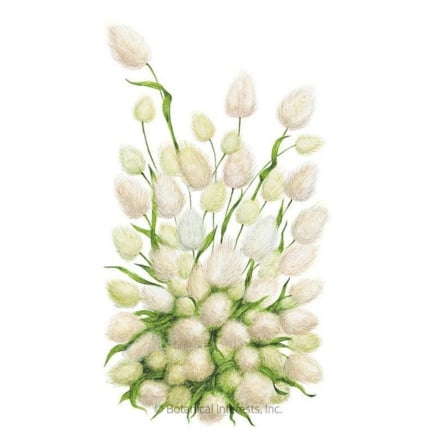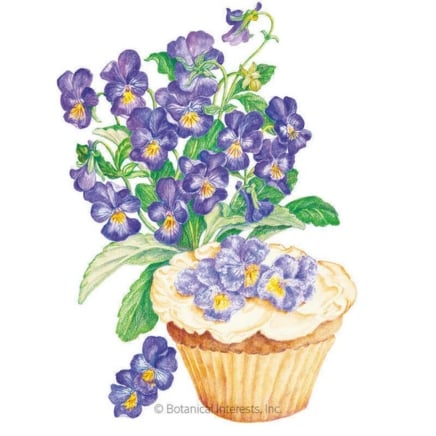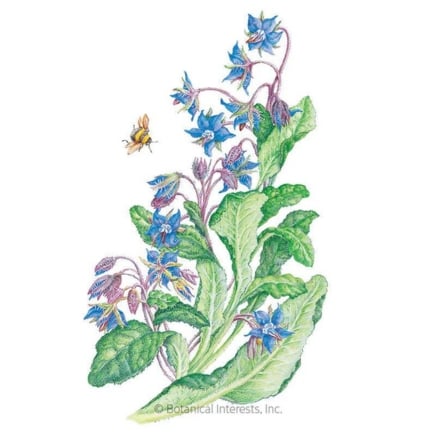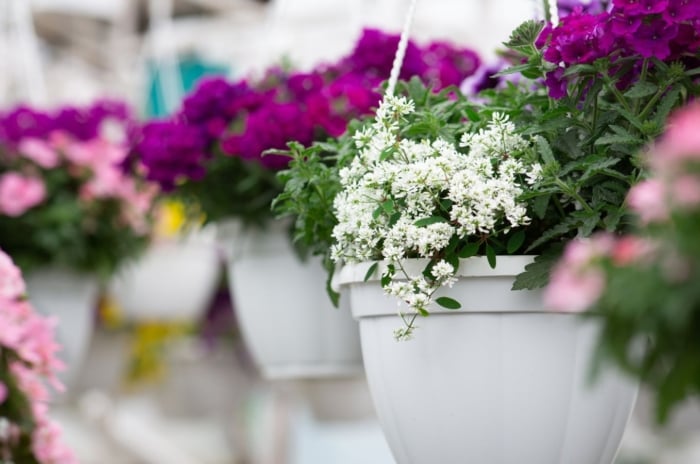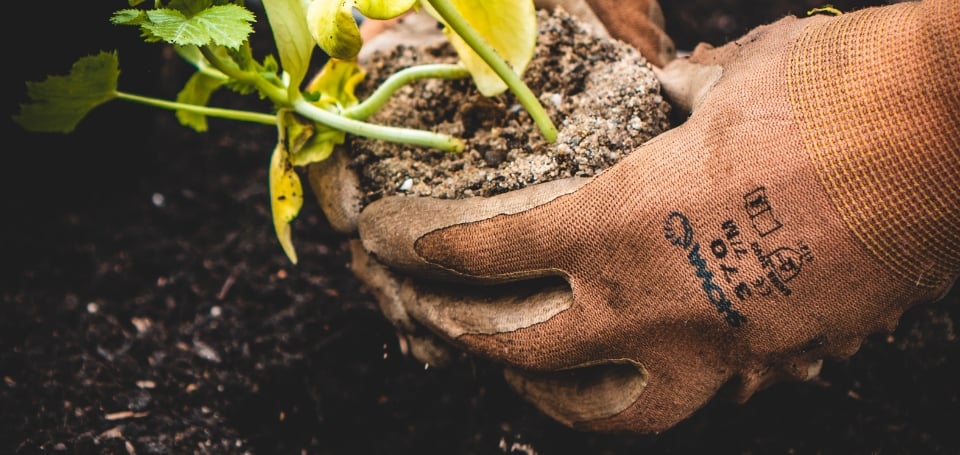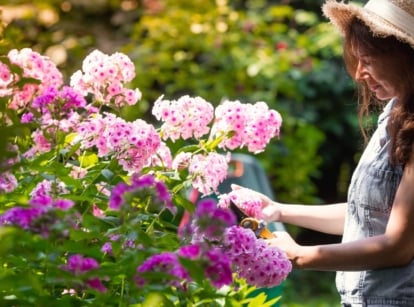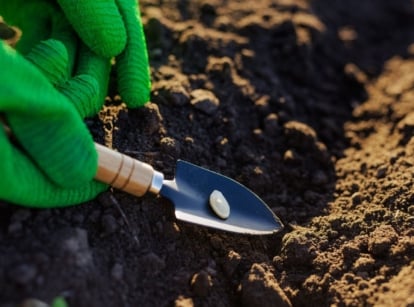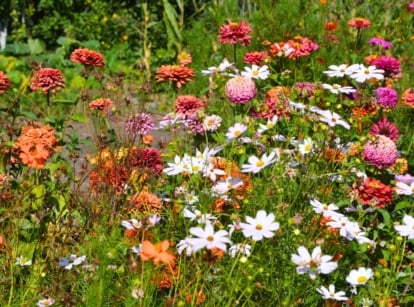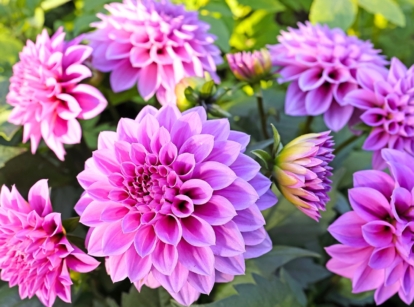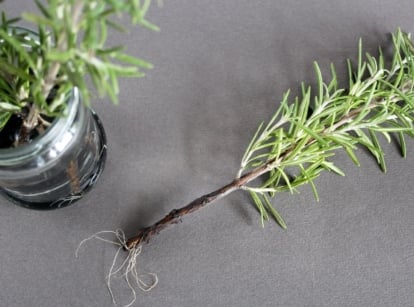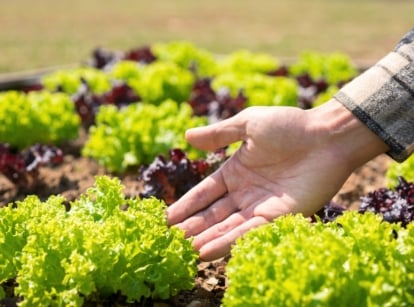15 Beautiful Container Ideas That Will Look Good Through Fall
Containers are superb for adding charm around the yard! Stuff them with plants, care for them, and move them as you see fit. Using a simple design called a thriller-filler-spiller trio, we’ll select three plants from the following 15 to make a lush, ornamental container that looks good through fall.

Contents
Fall is my favorite time of year! It offers relief from the heat of summer, and it’s like a mini-spring. Many wildflowers rush to bloom at the end of the year, and deciduous plants change their leaf color in response to cold temperatures.
The effect is stunning. Entire landscapes turn into wonderlands in autumn! With containers, you can capture some of this magic and scatter it throughout your garden. No yard is too small for containers.
Which plant species to put in the pots is a tricky decision. It depends on your local climate, your design preferences, and the size of your containers. All plants can live in pots for some time, though some, like the 15 on this list, are better suited for fall container ideas than others.
Create Beautiful Containers

Unlike plants growing in the ground, potted specimens need extra care to thrive in the garden. They grow best with good soil, consistent watering, and plenty of sunlight.
How much sun to give depends on the plants in question. Full sun plants need six or more hours of direct sunlight, while partial shade ones settle with three to six hours a day.
Good soil is the next parameter! It’s crucial for a healthy container. You want to use fresh potting soil when planting containers, either from a pre-made mix or a homemade blend.
I like to use FoxFarm potting soils for container plants. The soils are chock-full of nutrients from bat guano, earthworm castings, and aged forest products. They’re also porous and absorbent, which helps keep plant roots moist and protected from dry weather.
Go for their Happy Frog® potting soil for plants with low nutrient needs, and opt for Ocean Forest® if you’re growing specimens that need lots of nutrients. For a DIY soil mix, combine the following ingredients in a large bin:
- ⅓ Compost
- ⅓ Pumice, perlite, or vermiculite
- ⅓ Coco coir
Fall Container Ideas

What is the thriller-filler-spiller trio? It’s a fantastic fall container design idea that works for containers, raised beds, and in-ground beds.
You start by planting a thriller in the center or back of the container. A thriller is an upright plant with interesting foliage, flowers, or seed heads. Put the thriller in the center if you’re viewing the pot from all angles, and put it at the back if you’re looking at it from a single angle.
Around the thriller, you’ll plant fillers. Fillers are mounding, low-growing plants with blooms and attractive leaves. They will look good around the upright filler, as they “fill” the space with growth.
Spillers are vining or spreading specimens that spill over the edges of the container. They go around the fillers and grow out the pot.
For beautiful fall containers, choose combinations from each group to fill out the containers. You can come up with many fall container ideas with these essential plants.
Thrillers
A thriller makes a statement. Its purpose is to draw your attention to the container at hand. Upright, blooming shrubs, dwarf trees, and perennials make excellent thrillers. They’ll fulfill all of your fall container ideas!
Conifers

Where I live in the Pacific Northwest, conifers reign supreme! They’re some of the best garden plants. They need little pruning, they require less care than tender perennials, and they’re often frost-tolerant. Many will provide lush foliage in greens, yellows, or reds throughout the winter for ornamental interest.
Which conifer to choose for your fall container idea depends on the size of your pot. Choose dwarf cultivars, like the ‘Whipcord’ western red cedar, for small pots. Opt for bigger specimens for medium or large containers. Go for species in the Chamaecyparis, Cryptomeria, or Thuja genera; they have dozens of varieties to select from!
Frost and heat tolerance are the two most important factors to consider when choosing a conifer for your container. Select specimens that will survive the coldest winter temperatures and the highest summer temperatures typical for your region.
Ilex ‘Sky Pencil’

Sometimes you want a green plant as the thriller. This creates a neutral centerpiece that highlights the fillers and spillers beneath the central plant. If you want a classic, upright green shrub, go for the ‘Sky Pencil’ variety of Ilex.
‘Sky Pencil’ grows pencil-like, tall-standing stems that reach high in the sky! They’re upright and columnar. Beautiful green leaves sprout from the white-gray woody stems.
This cultivar pairs nicely with colorful fillers, like pansies, zinnias, and petunias. Let them fill the spaces around your ‘Sky Pencil’ with their bright blossoms and textured foliage.
Japanese Maple

Japanese maples are deciduous trees with lacy leaves and curvy, winding branches. Some reach impressive heights of 30 feet or taller, while dwarf varieties stay within a manageable height. Their soft leaves turn impressive hues of red, orange, and yellow through fall in response to cold temperatures.
After the leaves change colors, they fall to the ground in late autumn and early winter. The leaves fall to reveal the interesting bark underneath. Japanese maples have all-season interest, as they always have something interesting to look at!
These trees pair well with green, textured plants with mounding habits. Let your Japanese maple stand out in a container by choosing plain fillers and spillers that accentuate the tree’s features.
Oak Leaf Hydrangea

Oakleaf hydrangeas are U.S. native shrubs that grow wild throughout the eastern states. They’re exceptional! Not only are they beautiful, but they also offer all-season interest like Japanese maples. They sprout oak-shaped green leaves, peeling brown bark, and large panicles of white blooms.
This hydrangea may lean and grow downward branches if it sits in a container. Prune it annually after it blooms to keep it upright and well-structured.
Oakleaf hydrangea’s white flower heads are of a neutral color, meaning they’ll match with a variety of other blooms. Use other white-blooming specimens to make an all-white container, or opt for colorful wildflowers with many different hues.
Grasses

Small gardens don’t have room for a giant container with trees and big shrubs. Don’t worry! There are plenty of fall container ideas for small pots. Grasses offer hundreds, if not thousands, of species and varieties to choose from.
Ornamental grasses have thin, blade-like leaves, small flowers, and beautiful seed pods. There are many different varieties to choose from, depending on what colors, textures, and sizes you’re looking for.
Opt for grasses from the Calamagrostis, Pennisetum, and Muhlenbergia genera. These grasses perform well in pots, and they have dwarf cultivars for small gardens.
Fillers
Fillers fill empty spaces! They’re ideal for stuffing pots with leaves, blooms, and stems. For good-looking fall container ideas, choose fillers that bloom at summer’s end when temperatures cool and the weather turns mild.
Violet

Violets are cool-weather lovers with heart-shaped leaves and charming, dainty blooms. They have small root systems that fit nicely in containers. Tuck them in the nooks and crannies of your pots.
Violet flowers come in shades of purple, white, yellow, and pink. Dozens of native species grow across the U.S. Select a native violet to feed local butterflies, bees, and birds with nectar, pollen, and seeds. Native plants evolved alongside local critters, and the two need each other to survive.
Opt for the evergreen violet, Viola sempervirens, in the Pacific Northwest. It has yellow flowers and round leaves. Or, choose the common blue violet, V. sororia, in eastern and central portions of the country. It displays light lavender blooms and triangular leaves.
Pansy

Pansies are technically violets! The two plants are both in the genus Viola. Pansies are cultivated hybrids, and their lineage contains a few different violet species. Pansies differ from violets in their hardiness, bloom colors, and flower sizes.
These fall container plants have large flowers that are twice or three times the size of violet flowers. There are single and multi-color petals in shades of purple, yellow, white, pink, orange, and blue. These short-lived perennials provide an endless array of varieties that look good with different thrillers and spillers.
Pansies live short lives. They tend to die back when temperatures turn too hot in spring and summer. They’re perfect for fall container ideas, as they’ll bloom well into the middle of winter in regions with mild frosts.
Chrysanthemum

Chrysanthemums fill stores in autumn with fall-colored blossoms. They’re perennial in some zones, and frost-tolerant annuals in others. Pick up a few from your local garden center when they become available, or order them in the spring to have them ahead of the fall season.
These frost-tolerant perennials may crowd out some low-growing thrillers in your container. Pair them with upright specimens, like Ilex ‘Sky Pencil,’ so that both plants have enough space to grow. You may pinch the chrysanthemums in early spring to keep them short and squat.
Most chrysanthemums are hardy in USDA hardiness zones 3 through 9. They’ll likely come back the following year if you plant them in spring or late summer.
Zinnia

Zinnias are famous for their multi-color flowers! Growers release new hybrids annually with interesting bloom structures, different colors, and various sizes. Try a new funky variety, or select an old favorite heirloom.
A new favorite of mine is ‘Giant Purple.’ It sports lush, violet petals, and the flowers are ginormous! They’re some of the biggest zinnias available. If you like uniqueness, opt for the ‘Queeny Lime’ varieties. They have rolled inner petals with yellow hues that contrast beautifully with the orange or red opened petals.
Zinnias are excellent container specimens, and they work well for making bouquets and floral arrangements. Snip the flowers continuously to keep the plants consistently blooming. They’ll produce flowers up until the first frost.
Borage

Borage is an edible herb that bees love! They flock to the flowers from spring through fall. The blue blossoms turn purple-pink as they age, and they’re edible. Candy them with egg whites and sugar, or spread them on salads and charcuterie boards.
Borage is ideal for fall containers, as it’s frost-tolerant and it readily reseeds itself. You’ll see new seedlings pop up in the pot or the surrounding soil below. Plant it once and you may never have to plant it again!
Borage may grow tall and leggy in a container if it receives too much shade. Grow them with upright thrillers that let light through, like Japanese maples or ornamental grasses, to help them look good.
Spillers
Spillers, as their name suggests, spill over the edge of the containers. Their lengthy vines and long growing stems cascade out, creating lush, beautiful displays. Choose one with leaves and blooms that match your thriller and filler.
Black-Eyed Susan Vine

Black-eyed Susan vine isn’t related to black-eyed Susans, though it sprouts flowers that look similar to the native perennial! This vine is an evergreen tropical perennial, meaning it’s frost-tender and won’t survive the winter in cold regions.
Despite its lack of frost-resistance, black-eyed Susan vine fares well in the fall garden. Their orange and yellow flowers will tumble over the container’s edge and create a beautiful display.
You may overwinter this vine indoors in cold regions. Simply move the container to a bright, warm location indoors next to a window or grow lights. Then, move the plant back outdoors the next spring.
Bleeding Heart Vine

Bleeding heart vines are slightly frost-tolerant and late blooming, making them superb for containers. They’re deciduous vines, meaning they’ll die back to the ground at the end of the season and emerge anew in spring.
Off the lush, green stems sprout yellow, bleeding heart flowers that shine in the garden. Use them to fulfill your fall container ideas! Let the vines spill over the container’s edge, or have them grow up your thriller plant.
Because bleeding heart vines emerge anew in spring, they’re perfect for pairing with other winter-hardy perennials. Use them with ornamental grasses, hardy conifers, and cold-tolerant evergreens.
Vinca

Vinca is a longtime favorite perennial for the garden. It’s falling off in popularity, partially because it’s invasive in some states! The unruly vines crowd out native plants in wild areas. Consider using native alternatives, or chop off its spent blooms each year to prevent it from spreading.
Container culture is better for vinca than growing it in the ground, as a pot will help limit its spread. You can easily trim the long vines at the end of the growing season to prevent them from sprouting on the ground.
Vincas tend to have periwinkle blooms and green leaves, though some varieties have white flowers or variegated leaves. Choose a favorite and let it spill over the edges of your beautiful container.
Creeping Broom

Creeping broom blooms in early spring, but it retains its lush leaves throughout the year. It’s ideal for growing in containers, as it’ll pour out over the ends of the pot. Small, oval green leaves and thin, woody stems make this perennial an exceptional choice for container culture.
Creeping broom will creep naturally, and it needs no tending to perform well. Trim its ends if they get too long, and add compost into the container each spring to feed your broom for the rest of the year.
A deciduous shrub, this spiller loses its leaves in fall and early winter. Use it for all your design ideas! Combine creeping broom with conifers to balance out the evergreen growth, or consider pairing it with other deciduous species like Japanese maples and oak leaf hydrangeas.
Ice Plant

Ice plant rounds out this list in style! It’s a hardy succulent spreader with teardrop-shaped leaves and brilliant blooms. Find cultivars with pink, yellow, purple, orange, and yellow flowers. Purple blooming ice plants are the most common, though there is a wide range of types to choose from.
Blooming from spring through fall, ice plants are ideal specimens to bring beautiful container ideas to life. Some, like hardy ice plants, are frost-hardy! Choose hardy varieties if you garden in a region with harsh frosts.
They’ll perform better than frost-tender ice plants in the fall. Ice plants pair well with succulents and cacti to create a desert-like planting design. Combine them with other hardy, drought-tolerant specimens like windmill palms, manzanitas, and desert wildflowers.

